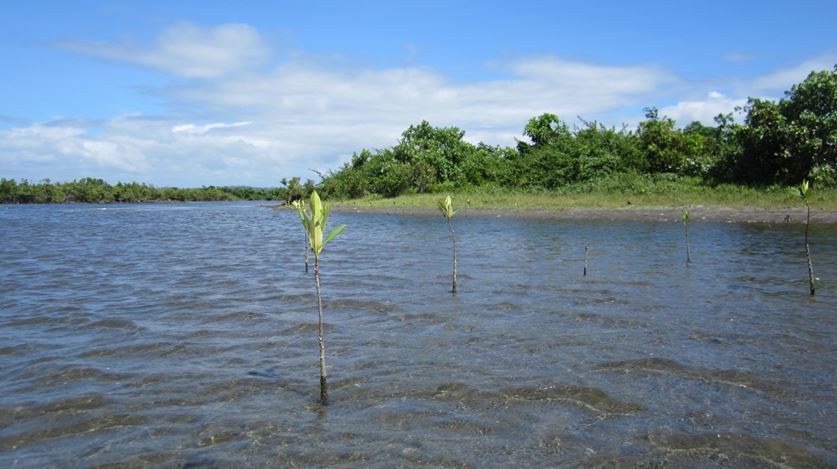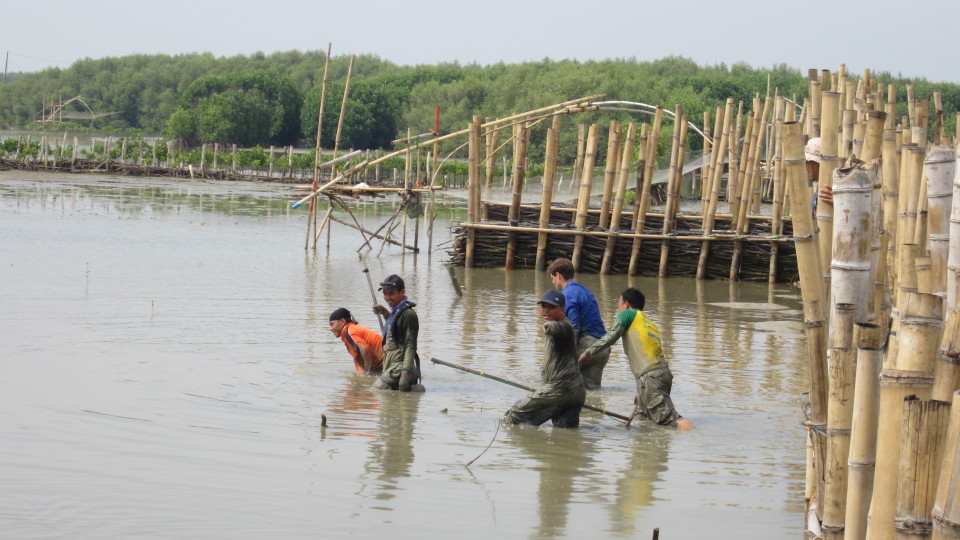
To plant or not to plant? Stopping malpractices in using mangroves to increase coastal resilience
-
Aquaculture, fisheries and coastal agriculture
-
Coastal resilience
-
Coastal wetland conservation
The last decade tsunamis and typhoon related surges in coastal areas across the world raised enormous interest for the role that mangroves can play in reducing flood risk. This is resulting in numerous projects that aim to increase community resilience and reduce risk by restoring mangrove forests. On the ground these projects basically encompass massive and well-meant planting of red mangrove. However, mostly this is done without a proper risk assessment and with little consultation of mangrove restoration experts. Unsurprisingly, many of these projects fail as many planted seedlings die. Even if seedlings are surviving, the ecological value of a monoculture and benefits of the planting efforts for increased community resilience are questionable. So what does it take to do mangrove restoration properly?
Mangrove restoration is mostly happening through planting of red mangrove propagules. The red mangrove makes a sort of seed on a stick and basically the planting involves sticking the stick in the mud. This seems so easy that you would think it cannot fail, but it does, as planting is often done in the wrong places where mangroves do not grow naturally. For example, seedlings are planted in areas that are submerged too many hours per day or where wave impact is too strong. Additionally, planting is also often done in situations where no planting is needed at all as there is sufficient availability of seeds of natural mangrove species and they are very well able to settle naturally if the conditions are right.
But nobody is really harmed by mangrove planting, right?
Unfortunately, this is not true. First of all, single species planting creates monocultures that are not resilient to storms and surges. After hurricane Haiyan in the Philippines all the planted mangrove forests disappeared. In addition, although mangroves do reduce surges and waves, restored mangrove belts do not often extend for more than 100 meters. While 100 meter reduce small day-to-day waves, it is too small to significantly impacts large waves or surges. If small planted mangrove belts are perceived as safe solutions against any hazard, people living behind these belts may decide not to evacuate in case of hurricanes or storm surges. Hence, framing small scale restoration efforts of single species mangrove belts as disaster risk reduction in fact makes people more vulnerable and may even put their life at risk.
Besides harming peoples’ safety, planting mangroves in the wrong areas is harming local ecosystems. Other vulnerable ecosystems, such as sea grasses, or natural mangrove seedlings are destroyed in the act of planting as they are trampled over by planting volunteers. Mangroves are regularly being planted in sea grass ecosystems that are the main food source for dugongs and living areas for many fish and shellfish species, and on tidal flats that constitute the main feeding grounds for many shorebirds. The basic rule of thumb is to not plant mangroves in areas where they were never present. The final risk of failing mangrove planting is that it will cause people to stop believing in the value of ecosystem based adaption. Rather unnecessarily because it can be done well!
The mangrove doctor
If we are ill we go to a doctor and if our car breaks down we go to a mechanic, but if we want to restore an ecosystem we do not automatically connect necessary expert knowledge. Often money is directly channelled to grass root organisations or local communities. To me this is a strange perception and it is one of the main reasons of failure of mangrove projects after the Asian tsunami. The knowledge on mangrove restoration is out there, but it often does not seem to be connected to the projects on the ground. There is this beautiful profession that is called restoration ecology, and groups of very knowledgeable people, such as the IUCN mangrove expert group, and there are many good ecosystem scientists that understand what it takes to do ecosystem and mangrove restoration. The question is how we get these experts more closely involved in restoration efforts? Should they be involved in all projects, should they be reviewers, should each funder or country set up an expert panel for evaluation of restoration projects?

To plant or not to plant?
As a start we need scientists, local NGO’s and big funding agencies to be more cautious when implementing restoration projects and to involve the mangrove doctors at some level. While local communities should be involved from the onset of the restoration plans, mangrove restoration cannot be a community effort alone. Proper guidance by restoration ecologists and ecosystem scientists needs to be a prerequisite during project implementation. Especially, if projects are framed to serve risk reduction purposes, care should be taken and another group of experts, in flood risk management, should be brought in as well. So what does this mean for project implementation and how do we successfully do mangrove restoration? This brings me back to the critical question: to plant or not to plant?
In our project in Central Java we adhere the principles of Ecological Mangrove Restoration (EMR). EMR focuses on creating the right conditions for mangroves to grow back naturally. There is no planting involved. This way EMR promotes natural zonation and optimal species to site matching. In addition, it delivers fast growth of the forest and high survival rates and if implemented at scale it is a very cost-effective method. EMR has a sound scientific basis and is becoming ‘the new standard’ within the mangrove expert community. In our project under the Building with Nature programme in Indonesia, we are applying EMR along a stretch of 20km of severely eroded coast in Central Java.
Upcoming Seminar: To plant or not to plant
To contribute to the dialogue on best practice towards successful mangrove restoration, Building with Nature Indonesia will soon organize a seminar on ‘to plant or not to plant’ in Indonesia. We will keep you posted through this website and social media with the invitation, date, venue and registration instructions!
About the Building with Nature project
Partners under the Building with Nature Indonesia initiative aim to enhance coastal resilience for 70,000 vulnerable people in Central Java by avoiding further coastal flooding and erosion and by providing them with a long term perspective for sustainable economic development. We do this through a unique integration of mangrove restoration, small scale engineering and sustainable land use. The partners further aim for replication and scaling up of the Building with Nature approach to other rural and urban areas in Indonesia and other vulnerable muddy coastlines in the world, including through capacity building, knowledge exchange and embedding in policies and planning. In our project we collaborate between ecologists, engineers, physical geographers and aquaculture experts. We include and train local communities to ensure local uptake of project measures and government officials on different levels to tackle legal and policy issues.

